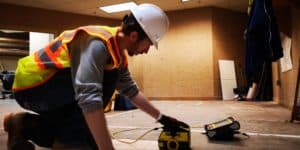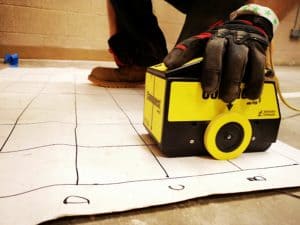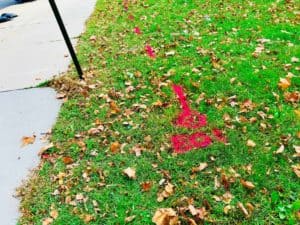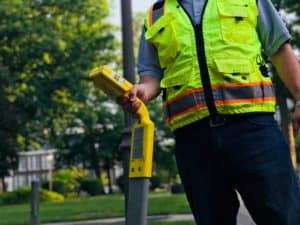We are frequently asked if we can x-ray concrete floors, walls, and columns. The simple answer is no, we cannot, nor do we want to. Using x-ray technology to scan concrete surfaces is very difficult due to the risk of radiation exposure from x-ray. Using ground penetrating radar technology in lieu of hazardous x-rays is a much safer and effective alternative.
Get the best bang for your buck.
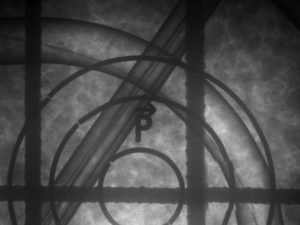 Although the x-ray images that are produced can be much higher quality than those produced by ground penetrating radar, it is typically much more cost-effective to utilize GPR for concrete imaging services. There are many factors and variables that will greatly increase the cost of using x-ray. If you’re like me, you’ve had a few x-rays of your body a few times. Do you remember the lead blankets or vests you had to wear to protect the rest of your body? Concrete x-ray services are no different. When performing a survey, the vicinity around the work area must be protected. This not only includes the vicinity left and right of the survey limits, but also includes the floors both above, and below the survey area. The added preparation not only costs more money in supplies and equipment, but it also takes much more time to setup and execute. What could be accomplished in under 30 minutes with the use of ground penetrating radar may take 4 hours or more with concrete x-ray scanning.
Although the x-ray images that are produced can be much higher quality than those produced by ground penetrating radar, it is typically much more cost-effective to utilize GPR for concrete imaging services. There are many factors and variables that will greatly increase the cost of using x-ray. If you’re like me, you’ve had a few x-rays of your body a few times. Do you remember the lead blankets or vests you had to wear to protect the rest of your body? Concrete x-ray services are no different. When performing a survey, the vicinity around the work area must be protected. This not only includes the vicinity left and right of the survey limits, but also includes the floors both above, and below the survey area. The added preparation not only costs more money in supplies and equipment, but it also takes much more time to setup and execute. What could be accomplished in under 30 minutes with the use of ground penetrating radar may take 4 hours or more with concrete x-ray scanning.
Additional factors that could dramatically increase the pricing of x-ray scanning services lay within the mobilization of the scanning company. Because this type of service is so specialized, the companies that make the investment in the equipment are far and few between. Mobilization can range anywhere from 5 miles to hundreds of miles depending on the location of your project site. Due to the size and quantity of equipment needed to perform concrete x-ray scans, the cost could add up pretty quickly. When compared to GPR scanning, the choice is clear for most construction, engineering, and concrete companies. GPR is more widely deployed among many service providers, making it much more accessible within close proximity to your job site. It is also much smaller. Most concrete scanning radar units are about the size of a suitcase (and some are even smaller). This makes mobilization a breeze and very cost effective.
Another factor driving up the cost of x-ray concrete scanning is the processing of the data that is collected. Because x-ray requires image processing with specialized equipment, most of the data processing is done offsite. This will require not only additional office time to process the data, but an additional site visit to physically mark out the findings. Ground penetrating radar data can also be processed in the office, but almost all GPR systems have the flexibility of providing real-time data analysis, allowing the technician to mark out their findings in real time as the service is performed.
Concrete surface x-ray is also limited to the types of surfaces it can image. Use of x-ray requires the technician to access both sides of the concrete surface that is being imaged. This will in most circumstances eliminate the ability to scan slab on grade concrete. Using ground penetrating radar however, slab on grade services can be scanned and results can be produced fast in as little as 10 minutes.
There is a bright side.
Ground penetrating radar is excellent and providing data regarding a targets horizontal and vertical position within the concrete surface, but is historically poor at determining the size of a target. It is nearly impossible to tell the difference between number eight and number six rebar using ground penetrating radar.One benefit that concrete x-ray imaging offers over ground penetrating radar is with the clarity of the image that is produced. We equate this to comparing x-ray images of the human body to ultrasound images of an unborn child. Although the ultrasound images will give you the basic shape and position of the baby, there is much to be desired with the clarity of the image.
Utilizing concrete x-ray is a much better application if you need to determine the exact size of the reinforcement within the concrete structure. The x-ray images will return a picture depicting all ferrous metal objects as if the concrete didn’t even exist. When calibrated correctly, precise measurements can be taken.





